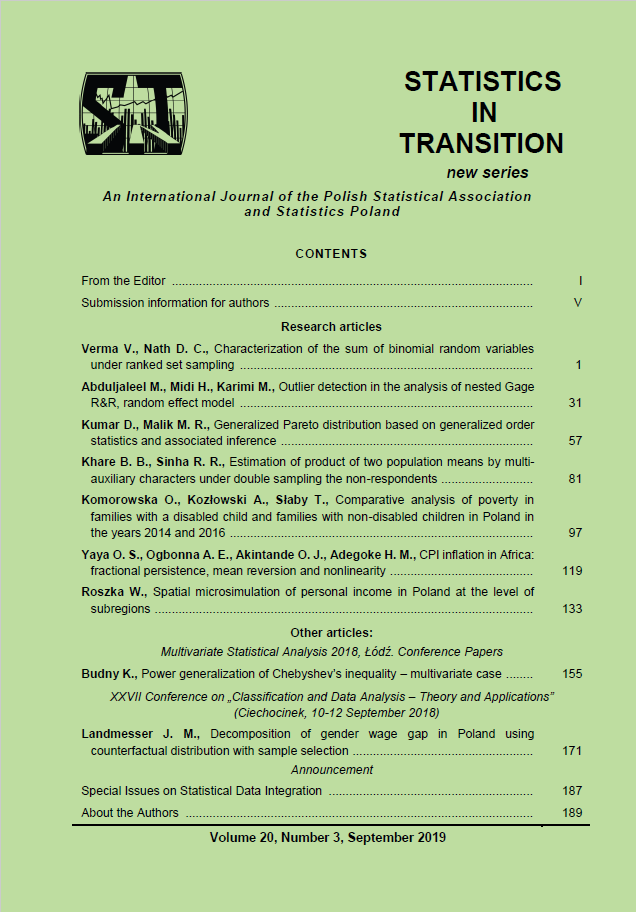ARTICLE
ABSTRACT
Measurement system analysis is a comprehensive valuation of a measurement process and characteristically includes a specially designed experiment that strives to isolate the components of variation in that measurement process. Gage repeatability and reproducibility is the adequate technique to evaluate variations within the measurement system. Repeatability refers to the measurement variation obtained when one person repeatedly measures the same item with the same Gage, while reproducibility refers to the variation due to different operators using the same Gage. The two factors factorial design, either crossed or nested factor, is usually used for a Gage R&R study. In this study, the focus is only on the nested factor, random effect model. Presently, the classical method (the method of analysing data without taking into consideration the existence of outliers) is used to analyse the nested Gage R&R data. However, this method is easily affected by outliers and, consequently, the measurement system’s capability is also affected. Therefore, the aims of this study are to develop an identification method to detect outliers and to formulate a robust method of measurement analysis of nested Gage R&R, random effect model. The proposed methods of outlier detection are based on a robust mm location and scale estimators of the residuals. The results of the simulation study and real numerical example show that the proposed outlier identification method and the robust estimation method are the most successful methods for the detection of outliers.
KEYWORDS
measurement system analysis, mm location, nested Gage R&R, outlier, residuals
REFERENCES
MACINTOSH, N. B., QUATTRONE, P., (2010). Management accounting and control systems: An organizational and sociological approach: John Wiley Sons.
BOURNE, M., MELNYK, S., FAULL, N., FRANCO-SANTOS, M., KENNERLEY, M., MICHELI, P., GRAY, D., (2007). Towards a definition of a business performance measurement system. International Journal of Operations and Production Management, 27(8), pp. 784–801.
HE, S.-G., WANG, G. A., COOK, D. F., (2011). Multivariate measurement system analysis in multisite testing: An online technique using principal component analysis. Expert Systems with Applications, 38(12), pp. 14602–14608.
BURDICK, R. K., BORROR, C. M., MONTGOMERY, D. C., (2003). A review of methods for measurement systems capability analysis. Journal of Quality Technology, 35(4), p. 342.
AWAD, M., ERDMANN, T. P., SHANSHAL, Y., BARTH, B., (2009). A measurement system analysis approach for hard-to-repeat events. Quality Engineering, 21(3), pp. 300–305.
PERUCHI, R. S., BALESTRASSI, P. P., DE PAIVA, A. P., FERREIRA, J. R., DE SANTANA CARMELOSSI, M., (2013). A new multivariate gage R&R method for correlated characteristics. International Journal of Production Economics, 144(1), pp. 301–315.
GREJDA, R., MARSH, E., VALLANCE, R., (2005). Techniques for calibrating spindles with nanometer error motion. Precision engineering, 29(1), pp. 113–123.
PARKER, D. H., ANDERSON, R., EGAN, D., FAKES, T., RADCLIFF, B., SHELTON, J. W., (2005). Weighing the world’s heaviest telescope at eight points with corrections for lifting perturbations. Precision engineering, 29(3), pp. 354–360.
PIRATELLI-FILHO, A., FERNANDES, F. H. T., ARENCIBIA, R. V., (2012). Application of virtual spheres plate for AACMMs evaluation. Precision engineering, 36(2), pp. 349–355.
BURDICK, R. K., BORROR, C. M., MONTGOMERY, D. C., (2003). A review of methods for measurement systems capability analysis. Journal of Quality Technology, 35(4), p. 342.
WANG, F.-K., CHIEN, T.-W., (2010). Process-oriented basis representation for a multivariate gauge study. Computers Industrial Engineering, 58(1), pp. 143–150.
FLYNN, M. J., SARKANI, S., MAZZUCHI, T. A., (2009). Regression analysis of automatic measurement systems. IEEE Transactions on Instrumentation and Measurement, 58(10), pp. 3373–3379.
PARENTE, E., PATEL, H., CALDEO, V., PIRAINO, P., MCSWEENEY, P. L., (2012). RP-HPLC peptide profiling of cheese extracts: a study of sources of variation, repeatability and reproducibility. Food Chemistry, 131(4), pp. 1552–1560.
HOFFA, D. W., LAUX, C. M., (2007). Gauge R&R: an effective methodology for determining the adequacy of a new measurement system for micron-level metrology.
ERDMANN, T. P., DOES, R. J., BISGAARD, S., (2009). Quality quandaries* a gage R&R study in a hospital. Quality Engineering, 22(1), pp. 46–53.
NO, A., COMMITTEE, A. M., (2015). Using the Grubbs and Cochran tests to identify outliers. Analytical Methods, 7(19), pp. 7948–7950.
STEVENS, N. T., STEINER, S. H., BROWNE, R. P., & MACKAY, R. J., (2013). Gauge R&R studies that incorporate baseline information. IIE Transactions, 45(11), pp. 1166–1175.
EXCEL SPC FOR EXCEL, (2013). Access date: 1 January 2017 “Destructive Gage R&R Analysis” https://www.spcforexcel.com/knowledge/measurement-systems-analysis/destructive-gage-rr-analysis.
RELIASOFT CORPORATION., EXPERIMENT DESIGN AND ANALYSIS REFERENCE, (2015), Worldwide Headquarters, p. 379.
LEE, E. F., CZABOTAR, P. E., SMITH, B. J., DESHAYES, K., ZOBEL, K., COLMAN, P. M., FAIRLIE, W. D., (2007). Crystal structure of ABT-737 complexed with Bcl-x L: implications for selectivity of antagonists of the Bcl-2 family. Cell death and differentiation, 14(9), p. 1711.
MIDI, H., ABU BAKAR, N. M., (2015). The Performance of Robust-Diagnostic F In The Identification Of Multiple High Leverage Points. Pakistan Journal of Statistics, 31(5).
FEARN, T., THOMPSON, M., (2001). A new test for ‘sufficient homogeneity’. Analyst, 126(8), pp. 1414–1417.
WALSH, S. J., MACSIK, Z., WEGRZYNEK, D., KRIEGER, T., BOULYGA, S., (2016). Model diagnostics for detecting and identifying method repeatability outliers in precision studies: application to a homogeneity study under a two-stage nested ANOVA. Journal of Analytical Atomic Spectrometry, 31(3), pp. 686–699.
ROUSSEEUW, P. J., HUBERT, M., (2011). Robust statistics for outlier detection. Wiley Interdisciplinary Reviews: Data Mining and Knowledge Discovery, 1(1), pp. 73–79.
